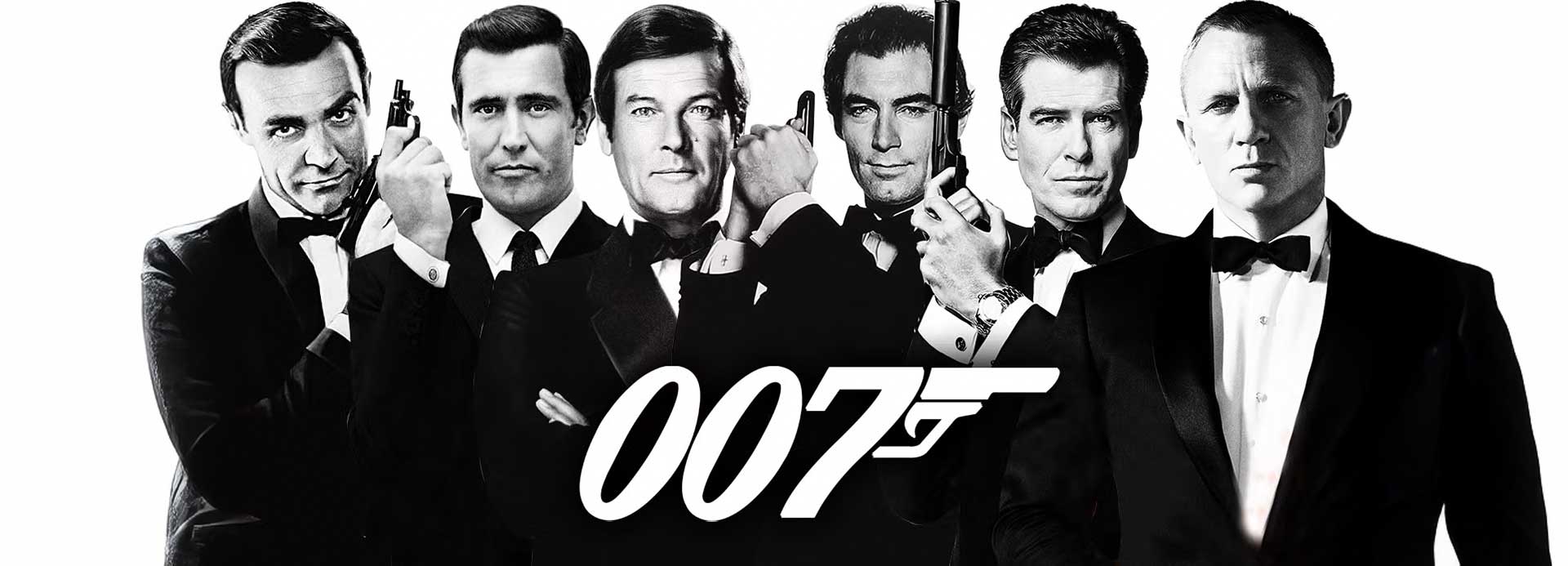

We’ve all heard or spoken these words at some point in our lives. With 23 feature films and numerous books chronicling the missions, adventures, and romances of the iconic 007 agent, it’s no wonder James Bond remains one of the most beloved and recognizable secret agents in fiction.
Since childhood, I have been fascinated by the 007 James Bond movies. I’ve also read all of Ian Fleming’s novels—perhaps the only books I’ve ever truly enjoyed reading.
Is there really a best James Bond actor, or does it all come down to who defined the role during your favorite era? Since Dr. No first hit theaters in 1962, the Bond franchise has been a beloved part of cinema, with 27 films and 12 actors shaping the suave spy we know today.
In our Ultimate Guide, we take you on a journey through the world of 007—exploring the films in order, diving into the stories of each Bond actor, and even ranking their performances.
Whether you’re a longtime fan or just discovering the world of Bond, get ready to relive the unforgettable moments, see how the character has evolved, and take a peek at what’s next for this legendary spy.
The Author
Ian Fleming was a British author, journalist, and naval intelligence officer best known for creating the iconic character James Bond. Born on May 28, 1908, in London, England, Fleming led a fascinating life that heavily influenced his writing.
Early Life & Career
Fleming came from a wealthy and influential family. His father, Valentine Fleming, was a Member of Parliament and a friend of Winston Churchill. After attending Eton College and Sandhurst, Fleming tried various careers, including banking and journalism, before finding his calling in intelligence work.
World War II & Intelligence Work
During World War II, Fleming worked for British Naval Intelligence, where he was involved in espionage operations, deception tactics, and the planning of special missions. His experiences in intelligence inspired many of the gadgets, missions, and characters in the James Bond series.
The Creation of James Bond
After the war, Fleming retired to Jamaica, where he built his estate, Goldeneye. It was there, in 1952, that he wrote his first Bond novel, Casino Royale, introducing the world to the suave and deadly MI6 agent, 007. The book was an instant success, leading to a total of 12 novels and 2 short story collections.
Bond’s Popularity & Legacy
The James Bond novels became international bestsellers, known for their thrilling plots, exotic locations, sophisticated style, and memorable villains. The first film adaptation, Dr. No (1962), starring Sean Connery, cemented Bond as a global phenomenon.
Death & Legacy
Fleming passed away on August 12, 1964, at the age of 56 due to a heart attack. Despite his early death, his creation lived on, with the Bond franchise becoming one of the most successful in film history. Other writers, including Kingsley Amis and Anthony Horowitz, have continued writing Bond novels, keeping Fleming’s legacy alive.
A Cozy Look at the James Bond Film Legacy
For over six decades, the James Bond franchise has thrilled audiences with action-packed adventures, stylish espionage, and unforgettable characters. Since Dr. No first graced the big screen in 1962, a total of 27 films have shaped the legacy of 007, culminating in No Time to Die (2021).
Each new Bond actor has brought their own unique spin to the role, often redefining the character for a new era. Sean Connery set the gold standard for charm and sophistication in Dr. No, while Daniel Craig introduced a grittier, more grounded Bond in Casino Royale (2006). The franchise has evolved alongside cinematic trends, from the sleek and humorous touch of Roger Moore in The Spy Who Loved Me (1977) to the darker, more intense take of Timothy Dalton in The Living Daylights (1987) and Licence to Kill (1989).
With each new film, the Bond series has reflected the cultural and cinematic shifts of its time, proving that 007 isn’t just a secret agent—he’s a timeless icon.
Profiles of James Bond Actors
James Bond has become a symbol of charm, sophistication, and action, and over the years, 12 actors have shaped the character in their own unique ways. Here’s a cozy look at the actors who brought 007 to life:
Barry Nelson
Barry Nelson holds a unique place in the history of James Bond, as he was the first actor to portray the character on screen—though not in an official Bond film. In 1954, Nelson played Bond in a television adaptation of Casino Royale, which was part of the Climax! Mystery Theater series. This version was not part of the EON Productions films and was an American-made TV special.
In this adaptation, Nelson’s Bond was a more straightforward, Americanized version of the iconic British spy. Interestingly, Nelson’s Bond was not yet known as “007” (he was just called “James Bond”), and the tone of the show was very different from what audiences would later see in the EON films. The character was portrayed as a more conventional, less suave figure compared to the Bond that would later become a cinematic legend.
Sean Connery
The first and perhaps most iconic Bond, Sean Connery debuted in Dr. No (1962) and set the standard for the character. He perfectly balanced suave sophistication with rugged toughness, making Bond both charming and deadly. Connery’s six-film tenure includes beloved classics like Goldfinger (1964) and From Russia with Love (1963), where his Bond became the definitive 007 for many fans.
David Niven
Though not part of the main series, David Niven played Bond in the unofficial Casino Royale (1967), offering a comedic and satirical twist on the character. This Bond was far lighter, and Niven’s portrayal remains an interesting, quirky part of Bond’s history.
George Lazenby
In just one film, George Lazenby made a lasting impact. His portrayal in On Her Majesty’s Secret Service (1969) was more emotional and vulnerable, which stood in stark contrast to Connery’s tough Bond. Though Lazenby’s time as 007 was short, his take on the character has earned a loyal cult following.
Roger Moore
Roger Moore brought a lighter, more humorous Bond to the screen starting with Live and Let Die (1973). Known for his wit and charm, Moore’s Bond could diffuse tension with a smile. His seven-film run, including The Spy Who Loved Me (1977) and Moonraker (1979), is remembered for its fun and adventure.
Timothy Dalton
Timothy Dalton took Bond back to his darker roots. In The Living Daylights (1987) and Licence to Kill (1989), Dalton’s Bond was morally ambiguous, intense, and much more serious. His portrayal was a grittier, more grounded 007, which resonated with fans craving a return to the character’s serious side.
Pierce Brosnan
With Pierce Brosnan, Bond was a perfect blend of grit and camp. Starting with GoldenEye (1995), Brosnan revitalized the franchise and became known for his smooth and charming 007. His Bond was both sophisticated and action-packed, with standout films like Tomorrow Never Dies (1997) and The World Is Not Enough (1999).
Daniel Craig
Daniel Craig brought a modern, more vulnerable take to Bond, starting with Casino Royale (2006). His portrayal was deeper, more complex, and had a gritty edge that matched contemporary cinematic trends. Craig’s Bond explored the emotional toll of being 007, with powerful performances in films like Skyfall (2012) and No Time to Die (2021), marking his final appearance in the role.
Each actor has added something special to the character, shaping James Bond into the iconic figure we know today.
Notable James Bond Films
The James Bond franchise is filled with a wide range of films, some hailed as cinematic masterpieces and others criticized for their shortcomings. The varying quality of the Bond films reflects the changing tastes and expectations of audiences over time. Here’s a cozy dive into some of the best and worst Bond films:
Best James Bond Films
Goldfinger (1964) is often considered one of the best Bond films of all time. Why? It’s got the perfect mix of everything that defines Bond—an iconic villain, unforgettable gadgets, and Sean Connery‘s definitive portrayal of the spy. The film was a commercial and critical success, setting a high bar for future entries in the series.
Casino Royale (2006) marked a fresh new start for the franchise, with Daniel Craig making his debut as Bond. This film stands out for its gritty realism, emotional depth, and complex storyline. The high-stakes poker scenes added a unique element to the Bond formula, and the film revitalized the franchise for a new generation.
Skyfall (2012) is another standout in the series, often praised for its stunning cinematography and in-depth exploration of Bond’s character. Directed by Sam Mendes, Skyfall is celebrated for its compelling plot, strong performances, and visual artistry. The film broke box office records and won numerous awards, making it one of the most revered Bond films.
Worst James Bond Films
Die Another Day (2002) is often criticized despite its commercial success. Why? Its over-the-top gadgets, an implausible plot, and excessive use of CGI made it feel less grounded in reality. While Pierce Brosnan delivered a solid performance, the film’s lack of realism and coherence led to its negative reception among critics and fans.
A View to a Kill (1985) is frequently cited as a low point in the franchise. With an uninspired plot, lackluster action scenes, and Roger Moore‘s visibly aging Bond, this entry failed to impress. Despite the catchy Duran Duran theme song, A View to a Kill didn’t quite live up to the expectations of a Bond film, earning its place among the less memorable entries.
Dieter’s Favorite
For Your Eyes Only (1981) is a standout Bond film, especially for Roger Moore’s performance. The opening ski chase sets an exciting tone, while the mountaintop fight on a cable car adds a sense of danger. The underwater car chase is another iconic sequence, showcasing Bond’s gadgets in thrilling action. The final confrontation at the monastery provides an intense and dramatic conclusion.
The theme song for For Your Eyes Only is also worth mentioning. Performed by Sheena Easton, it’s one of the few Bond songs to feature the singer on-screen during the opening credits. The song itself is a departure from the bombastic style of previous Bond themes, offering a more understated and emotional tone. It perfectly complements the film’s more grounded, serious approach and is remembered for its catchy melody and Easton’s heartfelt performance. It’s a great fit for the film’s blend of action and emotional depth.
The Bond girls in this film are memorable, particularly Carole Bouquet as Melina Havelock. She’s strong, intelligent, and driven by revenge, making her a standout character. Lynn-Holly Johnson plays Bibi Dahl, an Olympic swimmer whose playful infatuation with Bond adds a mix of comedy and tension.
Roger Moore’s performance in For Your Eyes Only is one of his best. His Bond is more grounded, with less humor and a stronger sense of seriousness. He shows a balance of charm and vulnerability that sets this film apart from his previous outings.
Evolution of the James Bond Character
Sean Connery’s portrayal of Bond in Dr. No (1962) set the stage for the suave, sophisticated spy we know today. His Bond was charming, confident, and exuded a sense of invincibility. Connery’s take on the character established the archetype of the gentleman spy—elegant, lethal, and ever-cool. This portrayal became the gold standard for all future actors to follow.
Roger Moore and Timothy Dalton each brought something unique to the role, reflecting the changing cinematic trends and societal attitudes of their times. Moore’s Bond, starting with Live and Let Die (1973), introduced a lighter, more humorous touch. His Bond relied more on wit and charm, resonating with audiences in an era where action films were becoming more lighthearted.
On the other hand, Timothy Dalton‘s portrayal in The Living Daylights (1987) and Licence to Kill (1989) offered a return to a darker, more intense Bond. His interpretation leaned closer to Ian Fleming’s original literary character, focusing on the spy’s moral ambiguities and emotional depth. Dalton’s Bond resonated with audiences seeking more complexity and emotional depth.
Daniel Craig’s Bond marked a major departure from the traditional portrayal. Starting with Casino Royale (2006), Craig’s Bond was more vulnerable and complex. This modern take on the character reflected contemporary cinematic trends, with a more grounded, gritty interpretation. Craig’s Bond faced personal struggles and vulnerabilities, making him more relatable and human. This evolution helped the franchise remain relevant and connected to modern storytelling techniques.
James Bond in Popular Culture
The impact of James Bond on popular culture cannot be overstated. The films have influenced everything from music to fashion, creating cultural touchstones that are still referenced today.
Iconic Theme Songs
Bond’s theme songs are just as legendary as the films themselves. From Shirley Bassey’s unforgettable Goldfinger to Adele’s haunting Skyfall, these songs have become symbols of their eras. The music sets the tone for the films, often enhancing the emotional depth of the story.
Memorable Gadgets
The gadgets used by Bond are an iconic part of the franchise, with inventions like the Aston Martin DB5’s ejector seat and the wristwatch with a laser capturing fans’ imaginations. These gadgets have even influenced real-world technology, as their creativity and ingenuity continue to inspire.
Famous Film Locations
James Bond films are known for their stunning, exotic locations. The Swiss Alps, the Bahamas, and the streets of London have all become synonymous with Bond. These locations are not just beautiful backdrops—they contribute to the grandeur and global appeal of the franchise.
Influential Cinematography
Bond’s visual style, from its dynamic action sequences to its elegant aesthetics, has set the standard for the espionage genre. The franchise’s cinematography has inspired countless other films and TV shows, with filmmakers emulating Bond’s sleek and sophisticated look.
Cultural References and Parodies
James Bond’s influence extends beyond film, with numerous parodies and references in pop culture. From Austin Powers to Johnny English, these spoof films exaggerate Bond’s characteristics, further cementing his place in popular culture. Whether it’s the gadgets, suave demeanor, or action-packed scenes, Bond’s essence continues to inspire and entertain audiences worldwide.
Final Words
From a deep dive into the chronological list of all James Bond films to detailed profiles of the actors who brought the iconic spy to life, this post has covered the full spectrum of the James Bond franchise.
We’ve explored the evolution of the character, ranked the best and worst actors, and highlighted some of the most memorable films in the series. Each era of Bond has offered something unique, from the classic elegance of Sean Connery to the gritty realism of Daniel Craig.
As the franchise looks ahead to its next chapter, fans around the world are eagerly awaiting the announcement of the next Bond. Will they continue the legacy of the suave secret agent, or will the character evolve even further? Only time will tell.
Whether you’re a long-time fan or just discovering the world of 007, there’s always something new and exciting in the world of James Bond. So, keep your eyes peeled for more thrilling adventures to come! The infographic below makes a new summary of the phenomena and the evolution of James Bond.


![Human Wonders 25 Years International Space Station ISS [Infographic] hero-image-25-years-ISS](https://www.skillzme.com/wp-content/uploads/2025/01/hero-image-25-years-ISS-200x200.jpg)
![What is the Artificial Intelligence of Things [Infographic] hero-image-infographic-Digital-Evolution-Series-Part-3](https://www.skillzme.com/wp-content/uploads/2024/11/hero-image-infographic-Digital-Evolution-Series-Part-3-200x200.jpg)
![A Visual Guide to AI Adoption by Industry [Infographic] hero-image-infographic-Digital-Evolution-Series-Part-2](https://www.skillzme.com/wp-content/uploads/2024/11/hero-image-infographic-Digital-Evolution-Series-Part-2-200x200.jpg)


Recent Comments